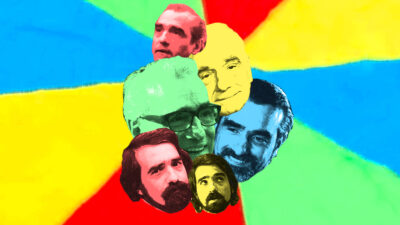Writer Hilary Jane Smith operates a weekly column all about the eternal cultural ephemera of the 1970s: it’s called Boogie Shoes, baby. We’re proud to be syndicating archived posts here at Merry-Go-Round Magazine. Originally published January 21st, 2022, this time Hilary dives into the raging bull himself: Marty. Subscribe to Boogie Shoes here.
Oh man, the late seventies: drug use, nightclubs, and dancing until 4 AM in flowy fabrics at Studio 54. All the buzzy, stereotypical hedonism was en vogue, and American tabloids were fascinated with the celebrities at the center of it all in New York City. This week’s snack is about how that glamorous façade hid a darkness underneath. It’s about the fallout from excessive behavior and a famous New Yorker who almost didn’t make it.
The protagonist is one Martin Scorsese – America’s beloved movie director grandpa, and visionary artist. We’re about to journey through the tumultuous, messy drama of making his prestige 1977 musical movie, NEW YORK, NEW YORK, and how Marty almost lost everything. A series of poor decisions and the pressures of fame resulted in drug addiction, divorce, and ultimately near-death. The stakes were extremely high, and Marty almost fell off a cliff.
So who was Martin Scorsese in the seventies and how did this happen?

Martin Scorsese circa 1977
I’m sure you’ve heard his name hundreds of times and probably watched at least one of his films. He notably won an Oscar for THE DEPARTED in 2006 after being nominated six separate times over the course of his career for Best Director. Other award-winning films he’s directed include RAGING BULL, GOODFELLAS, and THE WOLF OF WALL STREET to name a few. However, way before any of those awards, Martin Scorsese was a young director trying to prove himself, and after the success of his gritty 1976 film TAXI DRIVER, he decided on an ambitious, big-budget musical starring friend and co-collaborator Robert De Niro, and also the uber-famous singer/actress Liza Minelli. What could go wrong?
Well, to start, the film began shooting without a script, and Scorsese thought, because his other films had quite a bit of improved dialogue in them, his actors could improvise without words on the page. Also, Liza Minelli had a residency show booked in Las Vegas immediately following the shooting schedule, so there was added pressure to move forward without one. Taking on a major Hollywood film without a script, or a plan, doesn’t seem like a great decision, and Marty was overwhelmed. He had just won a major award for his last film, TAXI DRIVER, at the Cannes Film Festival, and he felt that this film had to be as or more successful. These feelings of inadequacy in the face of a daunting project, wrecked his self-confidence, and also gave way to destructive, self-loathing behavior.
Marty turned to cocaine as a crutch and became addicted. He has claimed in interviews that he tried to experiment with drugs to get the creative juices flowing, and he was also friends with a set of people who were heavy users. Scorsese pulled many all-nighters, relentlessly changing details to the unfinished film, almost as if he was building the plane while flying it.
Additionally, Marty was married to Julia Cameron, and, at the time of making the film, she was pregnant with their child. Unfortunately, Cameron was also an alcoholic. Her behavior towards the crew was erratic, and Marty wasn’t much help to manage the situation since he was dealing with his own drug problems. He would often hole up in his trailer, making their production delays worse, so he could talk to his psychiatrist on the phone.
Marty was already unfaithful to Julia prior to the film, but he decided to begin a relationship with Liza Minelli, who was also married to someone else. The affair was an open secret on set, causing more tension among the cast and crew. Talk about a hostile work environment paired with the fact that Liza and Marty would stay out until three or four in the morning partying and using drugs. They would arrive to set late or high which made the crew increasingly frustrated.
I’m not about to dictate the morality of this, or shame either of them, but I think the most insane part of the Minelli-Scorsese affair is the fact that Liza was also having an affair with notable Russian ballet dancer Mikhail Baryshnikov at the same time. Remember, Liza is also married as well. She’s got multiple men in her life to deal with. One time (probably coked-out), Martin Scorsese ran into her and her husband going for a walk and he confronted Liza about her relationship with the dancer. He berated her about the Baryshnikov affair as if she was betraying him. “How could you do this me?!?” he yelled at her, all the while her husband was standing by just watching it all go down on a street corner on the Upper East Side in Manhattan? So weird. Only in New York!

Martin Scorsese & Liza Minelli filming NEW YORK, NEW YORK
So anyway, while the movie-making is going on, Scorsese is dealing with his addiction, an unfinished script, a wife who is an alcoholic and pregnant, and anger issues making a high pressure situation worse.
Suddenly, mid-way through filming, Scorsese’s editor dies, and he’s without a key decision-maker for the movie. Freaking out, he calls up his good friends George and Marcia Lucas (yes, that George Lucas) and asks if Marcia can take a break from editing Star Wars to help him out. Apparently, she thought Star Wars was pretty lame and not going to be good (crazy, right?) and since she had worked on Scorsese’s previous film TAXI DRIVER, she jumped at the opportunity. George wasn’t too happy about her abandoning him for a better offer. He got even more upset when Marcia began spending late nights with the Scorsese celebrity-set at designer Halston’s apartment– a notorious party house. I mean, I don’t think my husband would be stoked either, but oh man, just one time, I would love to go out in 1970s New York City with Liza Minelli, Halston, and Martin Scorsese.

Following production Scorsese weighed about 109 pounds from stress and drug use
When the movie was finished and preparing to be released, Scorsese and his wife Julia were divorced. He essentially abandoned her and their healthy baby daughter, Domenica. Martin was deep into his drug use, and continuing his relationship with Liza, even if he didn’t like her laissez-faire attitude to monogamy (I mean, is he one to complain?) He even signed on to direct Liza Minelli’s new Broadway stage musical THE ACT, at her bequest, but was fired before it opened due to his inexperience with theater, and also his poor time management. He grew increasingly angry, and his explosive behavior became tabloid fodder and the subject of gossip in the industry.
When NEW YORK, NEW YORK was finally released, it was a box office failure, and barely made back its initial budget of $14 million ($64 million in 2022). His attempt to blend the artificiality of Old Hollywood glamour, with a gritty 1970s vibe was not appreciated by audiences and people found the story muddled and slow. It’s still seen as a disappointment when compared to Scorsese’s other work, but much more respected nowadays than when it first came out. The titular song was and still is extremely popular, especially after Frank Sinatra sang it during a Radio City Music Hall performance in 1978. Sinatra’s version became a Top 40 hit in 1980, and today, it is sung after every winning Yankees baseball game.
Post-NEW YORK, NEW YORK, Marty was still using a lot of cocaine and continued his violent, moody outbursts. He was angry at the way the film was received, he was divorced, fired from THE ACT, and the compounding failure became too much. To control his outbursts, Marty was put on Lithium for a few months to stabilize his moods, but cocaine remained his drug of choice.
Finally in 1978, the year after the film’s release, Marty attended the Telluride Film Festival with Robert De Niro and took bad-quality cocaine he scored from someone. He began to cough up blood and blacked out, and ultimately landed in a New York City hospital where he was diagnosed with severe internal bleeding and on the verge of a brain hemorrhage. Quaaludes, cocaine, and other substances mixed with his asthma medication were killing him, and at 5’ 4” he only weighed 109 pounds. While in recovery, De Niro visited Scorsese in the hospital and gave him some tough love that Scorsese cites as the reason he is alive:
“What’s the matter with you, Marty? Don’t you wanna live to see if your daughter is gonna grow up and get married? Are you gonna be one of those flash-in-the-pan directors who does a couple of good movies and it’s over for them?” – Robert De Niro, 1978 – from Easy Riders, Raging Bulls by Peter Biskind
While in the hospital, De Niro convinced Marty to direct him in their next movie collaboration, RAGING BULL. It went on to win multiple Oscars, and De Niro and Scorsese have worked on nine films together in the last fifty years.
Check out the most recent Boogie Shoes, an exploration of GARFIELD and consumerism, here, and be sure to subscribe today!










Comments